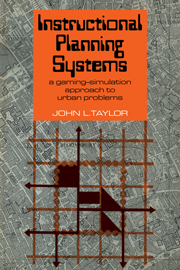Book contents
- Frontmatter
- Contents
- List of figures, tables and forms
- Acknowledgements
- 1 Point of departure
- 2 The basis for discussion
- 3 The genesis of an approach
- 4 Selected planning developments
- 5 Impact, pitfalls and pay-offs
- 6 A gaming-simulation rationale
- 7 Simulation in practice
- 8 The way ahead
- Appendices
- Bibliography
- Index
- Frontmatter
- Contents
- List of figures, tables and forms
- Acknowledgements
- 1 Point of departure
- 2 The basis for discussion
- 3 The genesis of an approach
- 4 Selected planning developments
- 5 Impact, pitfalls and pay-offs
- 6 A gaming-simulation rationale
- 7 Simulation in practice
- 8 The way ahead
- Appendices
- Bibliography
- Index
Summary
In concluding this examination of an instructional simulation approach to the urban development process, it seems appropriate to precede any summary observations with two sets of remarks. First, some comments are made on possible trends and characteristics likely to influence the general prospects for work in this field. Second, some notes are presented on a few of the barriers in the path of future progress and on the respective steps which may be necessary to continue and promote further advances. Finally, in drawing together what has gone before, some thoughts are expressed about what might have been revealed and what remains to be accomplished.
THE GENERAL OUTLOOK
In taking a considered view of the ‘state of the art’ it seems particularly relevant to be constantly reminded that, with the exception of war games, gaming-simulation is a post-1956 phenomenon and, more importantly, planning games are very much a post-1960 development. Despite the fact that, at present, urban development games are little more than experimental prototypes, the technique appears to be increasingly at the centre of a modest international ‘growth industry’. Not only are more games being designed and used year by year but there are ample indications to show that these models are slowly encompassing a wider range of activities and, in many cases, becoming increasingly more sophisticated.
- Type
- Chapter
- Information
- Instructional Planning SystemsA Gaming-Simulation Approach to Urban Problems, pp. 113 - 125Publisher: Cambridge University PressPrint publication year: 1971



